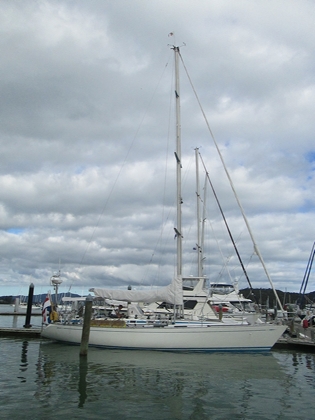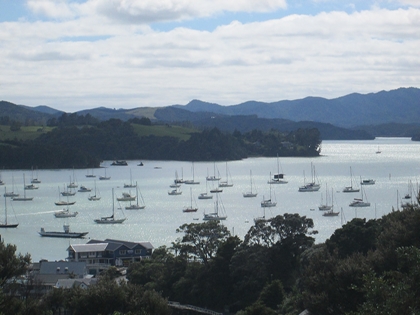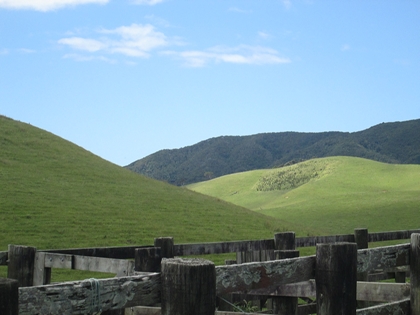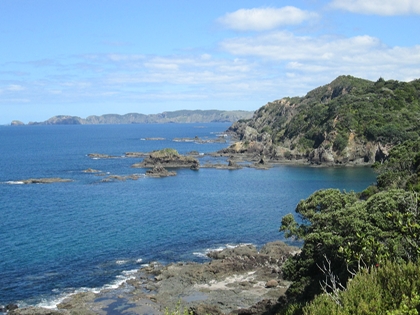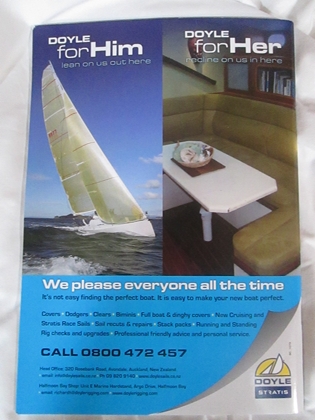Thursday 29th November - Early Days in NZ

|
Thursday
29th November – Early Days in NZ Apart from a
quick report saying that we’d arrived on the morning of Friday 23rd,
we left you on the evening of Wednesday 21st having just temporarily
sorted out the recurring diesel leak and having just discovered that the
domestic battery bank alternator wasn’t charging. After a bit of fiddling about we got it
to work, but only if the engine cover was off and then only for a while. Starting the auxiliary generator was an
option but not whilst the engine was running because Mr Perkins, who shares a
fuel line to the fuel tank with the generator, nicks most of the available
diesel and leaves too little for the generator. OK, but the domestic bank is important –
it drives the lights, auto-pilot (primary means of steering on a short-handed
boat) and the chart plotter (primary means of navigation). So, by Thursday evening we were getting
a touch twitched about getting some ergs into the batteries somehow. We stopped Mr Perkins for a while and
tried to start the generator. No
joy – it was pretty obviously a fuel starvation problem of one sort or another –
but not related to greedy Mr Perkins.
We tried to investigate the problem. So Jon was head down in the relevant
cockpit locker, bum out, unbolting the various bits and pieces of the generator
connected by the fuel line. No
sooner had he disconnected a few bits and bobs than the wind filled in and we
were closehauled in 20 – 25 knots of wind, well heeled and dealing with a bit of
a sea. So, no go. It obviously wasn’t going to get much
better so we stopped fiddling around and pressed on, using as little battery
power as we could, hoping to make Opua before the whole lot closed down on
us. And we did. We came
alongside the quarantine berth, to join at least a dozen other boats, at about
0730 on Friday morning and were cleared in by customs, immigration, bio-security
and all that a little later that morning.
Zero hassle. We knew they’d
take away any fresh foods and anything else they feared might infect NZ but were
prepared for that. Nobody probed
too deeply about the cleanliness of the underwater hull but it was clear that we
were reasonably clean. However, we
couldn’t connect up to the shore power until Saturday because the boat needed to
be inspected by a chap qualified to issue a Warrant of Fitness to verify that we
wouldn’t blow ourselves or anyone else up with dodgy DIY electrics. Apparently that’s because Kiwis, being
resourceful chaps, are apt to ‘have a go’ at installing boat electrical
installations themselves. And, in
the past, that hasn’t always worked quite as intended. So, Friday night was a bit dark on board
and the Cruising Club provided light, dinner and pleasant company.
Arnamentia safely tied up on the other side of the world – note grey
skies to remind us of home!
Opua is a
bit out in the sticks but the marina has a fairly comprehensive set of marine
engineering businesses on site as well as a couple of chandleries, laundry,
cruising club, café and so on. So,
Friday saw engineers both electrical and mechanical aboard and stuff getting
sorted. We also had both outboard
engines serviced and Mark, who serviced them, was very happy to have Jon as an
apprentice to learn how to do it.
Most outboard engine user manuals describe in detail what fuel to use and
how to put it in, wax lyrical about ‘elf’n’safety and tell you to take the
engine to a professional to get anything much more complicated than refuelling
or changing a spark plug done.
Changing the impeller?
Drowned your engine? Oh,
much too difficult for numpty customers.
Yeah, right. It ain’t always
that easy to find professional help when you need it. A couple of hours with Mark, a camera, a
notebook and a pencil whilst Mark worked on our own engines and answered the
‘what ifs’, was time massively well spent.
In common with all the Kiwis we have met here, either in a private or a
professional capacity, he is extremely friendly, knowledgeable, has time and is
delighted to help in any way possible.
We might
even get the new Lopolight fitted here.
This is a LED tricolour/anchor light mounted at the mast head. It’s excellent and uses very little
power. We had one fitted in about
2008. Recently the white LED
elements failed so that we had neither a stern light nor an anchor light. We did have port/starboard side
lights. No real problem – we have
alternatives for stern and anchor lights – but it needed to be sorted in due
course. Whilst in
Personal
mobility is an issue in NZ and you need to solve it if you are going to be here
for any length of time. It was more
or less as cheap to hire a car from Rent-a-Dent (“Quality Rental Vehicles”!) for
a day as to take a return taxi ride to the nearest town – about 5 miles
away. We did that over the weekend
and had a day out on Sunday.
Firstly we visited Russell, the original capital; it’s a pleasant little
town in a delightful bay very much geared up to the tourist market. One of the major sights is the
Pompallier Mission. Before, the
British grabbed NZ, the French were trying to make their mark here too. Pompallier, a determined French RC
bishop, spent some time living with the Maoris, learning their language and
culture. The Maoris paid more
attention to him than the Wesleyans because they thought that he looked a lot
more impressive in his purple silk robes than the Wesleyans did in their black
and austere attire. So, he was,
they felt, probably further up the food chain to Him. Bishop Pompallier translated the bible
into Maori and built a printing press, tannery and book bindery (?) all from
scratch. The original house has
been recreated along with all the presses, binders and tanning pits – everything
works and is quite authentic down to the use of wattle and urine in the very
whiffy tanning pits. It was there
that we learnt the origin of the phrases, “skiving off” (shaving the leather was
considered an easier job than rubbing it down whilst simultaneously stamping on
newly tanned hides), “a dab hand”, “to coin a phrase” and “cut to the
chase”.
The
afternoon saw us driving through switch back roads, some gravel, through a
hilly, verdant landscape bordering the
Very rolling farmland
Pacific coast near The longer
term solution to mobility is to buy a second-hand car and there are plenty of
these on offer from companies that specialise in selling these and guaranteeing
a buy-back price after 6 months or so.
So, we’ve done that and the upshot is that we have a 2 litre Honda in
good nick for $6,000 NZ which will be bought back from us for $4,000 NZ. You could undoubtedly do the sourcing
and re-selling of the car yourself and save most if not all of the $2,000
NZ. But . . .
So, our
first impressions of It’s been
lovely to meet up again with boats that we first met in Bora Bora and have been
bumping into (not literally) ever
since. We’re eagerly
anticipating the arrival in NZ of Sockdolager, a beautiful, 24 ft (yes, feet not
metres), tough Pacific Seacraft Dana which friends, Karen and Jim sailed from
In the
meantime, we’ll crack on attacking the list of chores which runs to about 50
items; so far it’s one winch serviced and 15 to
go! And finally,
we don’t think that the
|
